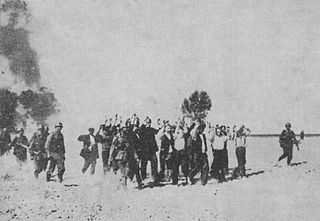
Operation Tannenberg was a codename for one of the anti-Polish extermination actions by Nazi Germany. The shootings were conducted with the use of a proscription list targeting Poland’s elite, compiled by the Gestapo in the two years before the invasion of Poland.
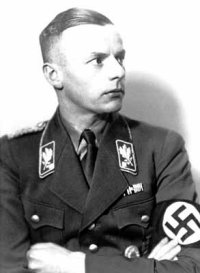
Friedrich-Wilhelm Krüger was a German paramilitary commander in charge of, and personally involved in progressive annihilation of the Polish nation, its culture, its heritage and its wealth. Long before the war he was a high-ranking member of the SA and the SS. Between 1939 and 1943 he was the Higher SS and Police Leader in the General Government, giving him command of all police and security forces in German-occupied Poland. In this capacity, he organized and supervised numerous crimes against humanity and had major responsibility for the German genocide of the Polish nation: the extermination of six million Poles and massive destruction, degradation and impoverishment of the Polish state. He committed suicide in May 1945.
The Wąsosz pogrom was the World War II mass murder of Jewish residents of Wąsosz in German-occupied Poland, on 5 July 1941. The massacre was carried out by local Polish residents without participation of Germans.

Bialystok District was an administrative unit of Nazi Germany created during the World War II invasion of the Soviet Union. It was to the south-east of East Prussia, in present-day northeastern Poland as well as in smaller sections of adjacent present-day Belarus and Lithuania. It was sometimes also referred to by the designation South East Prussia along with the Regierungsbezirk Zichenau, although in contrast to the latter, it was not incorporated into, but merely attached to East Prussia.

The Zamość uprising comprised World War II partisan operations, 1942–1944, by the Polish resistance against Germany's Generalplan-Ost forced expulsion of Poles from the Zamość region (Zamojszczyzna) and the region's colonization by German settlers.
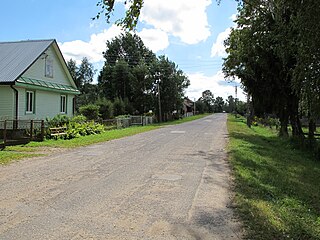
Rajsk is a village in the administrative district of Gmina Bielsk Podlaski, within Bielsk County, Podlaskie Voivodeship, in north-eastern Poland. It lies approximately 10 kilometres (6 mi) north of Bielsk Podlaski and 30 km (19 mi) south of the regional capital Białystok.

Michniówpronounced[ˈmixɲuf] is a village in the administrative district of Gmina Suchedniów, within Skarżysko County, Świętokrzyskie Voivodeship, in south-central Poland. It lies approximately 5 kilometres (3 mi) south of Suchedniów, 14 km (9 mi) south-west of Skarżysko-Kamienna, and 22 km (14 mi) north-east of the regional capital Kielce.
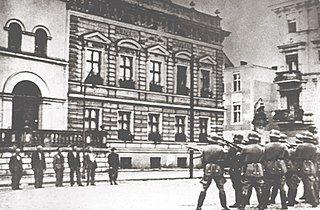
The Intelligenzaktion, or the Intelligentsia mass shootings, was a series of mass murders which was committed against the Polish intelligentsia early in the Second World War (1939–45) by Nazi Germany. The Germans conducted the operations in accordance with their plan to Germanize the western regions of occupied Poland, before their territorial annexation to the German Reich.

Around 6 million Polish citizens perished during World War II: about one fifth of the pre-war population. Most were civilian victims of the war crimes and crimes against humanity during the occupation by Nazi Germany and the Soviet Union. Approximately half were Polish Jews killed in The Holocaust. Statistics for Polish World War II casualties are divergent and contradictory. This article provides a summarization of these estimates of Poland's human losses in the war and their causes.

The ethnic cleansing of Zamojszczyzna by Nazi Germany during World War II was carried out as part of a greater plan of forcible removal of the entire Polish populations from targeted regions of occupied Poland in preparation for the state-sponsored settlement of the ethnic German Volksdeutsche. The operation of mass expulsions from Zamojszczyzna region around the city of Zamość was carried out between November 1942 and March 1943 on direct order from Heinrich Himmler. It was preplanned by both Globocnik from Action Reinhard and Himmler, as the first stage of the eventual murderous ethnic cleansing ahead of projected Germanization of the entire General Government territory.

The Monument to World War II Orthodox victims in Białystok is a privately funded memorial commemorating the memory of 5,000 Orthodox Christians from the Białystok region who perished in World War II and during the postwar repressions in Stalinist Poland.

The Sochy massacre occurred on 1 June 1943 in the village of Sochy, Lublin Voivodeship in Zamość County, Lublin Voivodeship during the German occupation of Poland when approximately 181–200 of its inhabitants, including women and children, were massacred by the German Ordnungspolizei and SS in retaliation for the village's support for the Polish resistance movement.

The Michniów massacre is a massacre that occurred on 12–13 July 1943 in the village of Michniów during German occupation of Poland when approximately 204 of its inhabitants, including women and children, were massacred by German Ordnungspolizei and Schutzstaffel.

The Mausoleum of the Martyrdom of Polish Villages in Michniów is a museum located in Michniów, in Świętokrzyskie Voivodeship, in Poland, constituting a branch of the Museum of the Kielce Village, commemorating the pacification actions in German-occupied Poland.

The Krasowo-Częstki massacre was a Nazi war crime perpetrated by the Ordnungspolizei and SS in the village of Krasowo-Częstki within occupied Poland. On 17 July 1943, the village was completely burned; 257 of its inhabitants, mostly women and children, were murdered. The massacre was an act of retaliation against the civilian population, after at least eight Germans were killed in a skirmish with Polish partisans in the nearby colony of Kalnik. It was the bloodiest pacification action conducted by Nazi-German occupiers in those areas of prewar Białystok Voivodeship, which after Second World War remain within the borders of Poland.

The Jabłoń-Dobki massacre was a Nazi war crime perpetrated by the Ordnungspolizei and Wehrmacht in the village of Jabłoń-Dobki within occupied Poland. On March 8, 1944, the village faced complete destruction, with an estimated 91 to 93 of its inhabitants, predominantly women and children, losing their lives. A significant number of victims were burned alive. This massacre served as a form of retaliation against the civilian population following the killing of a German gendarme during an earlier skirmish with Polish partisans in Jabłoń-Dobki earlier on the same day.
The Kitów massacre was a Nazi war crime perpetrated by the Ordnungspolizei and Schutzstaffel in the village of Kitów within occupied Poland. On December 11, 1942, a minimum of 164 inhabitants of Kitów, including numerous women and children, were killed in a mass execution. This massacre was part of the ethnic cleansing of the Zamość region and was additionally considered retaliation for a prior attack by Polish partisans on the village of Nawóz, which had been subjected to colonization by ethnic German settlers.

The Szarajówka massacre was a Nazi war crime perpetrated by the Ordnungspolizei and Ukrainian Auxiliary Police in the village of Szarajówka within occupied Poland. Occurring on May 18, 1943, this pacification action claimed the lives of up to 67 inhabitants, among whom were numerous women and children, many of whom were burned alive. The village was ransacked and completely burned. This atrocity was part of the ethnic cleansing of the Zamość region and was additionally seen as retribution against the civilian population for their support of the Polish resistance movement.
The Majdan Nowy massacre was a Nazi war crime perpetrated by the Schutzstaffel and its Ukrainian collaborators in the village of Majdan Nowy within occupied Poland. Taking place on June 24, 1943, this pacification operation resulted in the deaths of an estimated 28 to 36 residents, including women and children. This atrocity was part of the ethnic cleansing of the Zamość region.
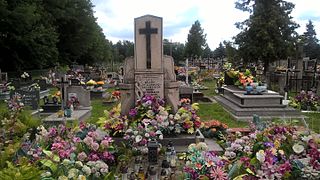
The Majdan Stary massacre was a Nazi war crime perpetrated by the Schutzstaffel and its Ukrainian or Soviet collaborators in the village of Majdan Stary within occupied Poland. Taking place on July 3, 1943, this pacification operation resulted in the deaths of an estimated 75 residents, including women and children. This atrocity was part of the ethnic cleansing of the Zamość region.
